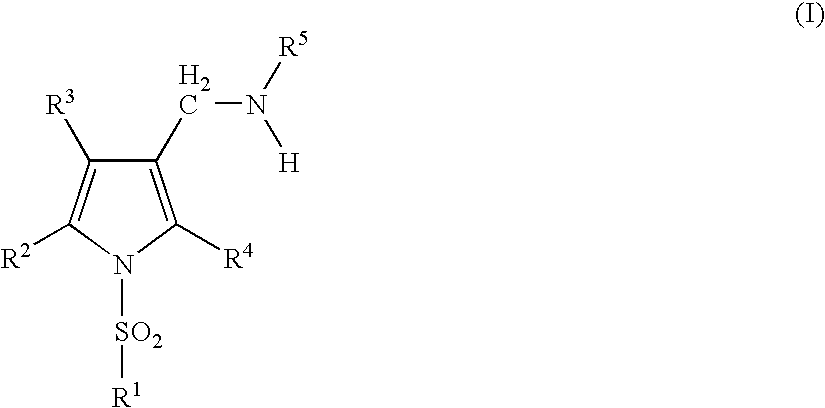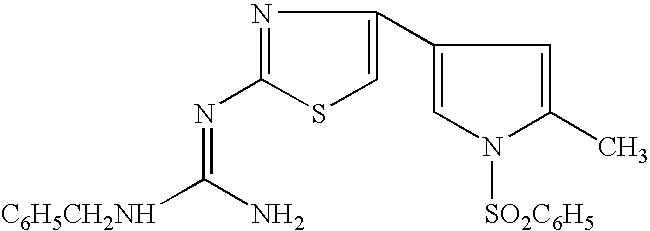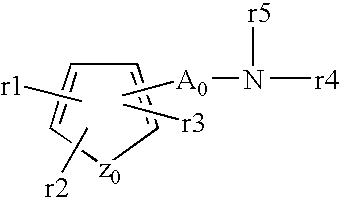Acid secretion inhibitor
a technology of acid secretion and inhibitor, which is applied in the direction of biocide, antibacterial agents, drug compositions, etc., can solve the problems of side effects and side effects of proton pump inhibitors, and achieve the effect of reducing side effects and reducing side effects
- Summary
- Abstract
- Description
- Claims
- Application Information
AI Technical Summary
Benefits of technology
Problems solved by technology
Method used
Image
Examples
reference example 1
2-bromo-1-(2-fluorophenyl)propan-1-one
[0221]To a solution of 2′-fluoropropiophenone (25.0 g) in acetic acid (250 mL) was slowly added bromine (8.4 mL). The mixture was stirred at room temperature for 3 hr, and concentrated under reduced pressure. Water (200 mL) was added to the residue, and the mixture was extracted with diisopropyl ether. The extract was washed with saturated aqueous sodium hydrogencarbonate solution, water and saturated brine, dried over anhydrous magnesium sulfate, filtered and concentrated under reduced pressure to give the title compound as a yellow oil (yield 36.8 g, 97%).
[0222]1H-NMR (CDCl3)δ: 1.89-1.91 (3H, m), 5.27-5.34 (1H, m), 7.12-7.19 (1H, m), 7.24-7.30 (1H, m), 7.52-7.59 (1H, m), 7.88-7.93 (1H, m).
reference example 2
ethyl 2-cyano-4-oxo-4-phenylbutanoate
[0223]Potassium carbonate (13.82 g) was added to ethyl cyanoacetate (37 mL), and the mixture was stirred at 40-45° C. for 45 min. A solution (100 mL) of phenacyl bromide (10.0 g) in acetone was added dropwise over 30 min. After completion of the dropwise addition, and the mixture was stirred at room temperature for 18 hr. The reaction mixture was filtered, and the filtrate was concentrated under reduced pressure. Water was added to the residue, and the mixture was extracted with ethyl acetate. The extract was washed with saturated brine, dried over anhydrous sodium sulfate, and concentrated under reduced pressure. Excess ethyl cyanoacetate contained in the obtained oil was evaporated under reduced pressure, and the residue was purified by silica gel column chromatography (eluent: hexane-ethyl acetate=8:1→1:1) to give the title compound as a pale-yellow oil (yield 10.41 g, 90%).
[0224]1H-NMR (CDCl3)δ: 1.35 (3H, t, J=7.2 Hz), 3.55 (1H, dd, J=16.0, 5...
reference example 3
methyl 2-cyano-4-(2-fluorophenyl)-3-methyl-4-oxobutanoate
[0225]To a solution of methyl cyanoacetate (15.5 mL) and diisopropylethylamine (64 mL) in tetrahydrofuran (110 mL) was added a solution of 2-bromo-1-(2-fluorophenyl)propan-1-one (36.8 g) in tetrahydrofuran (160 mL), and the mixture was stirred at 70° C. for 20 hr. The reaction mixture was allowed to cool to room temperature, the insoluble material was filtered off, and the filtrate was concentrated under reduced pressure. The residue was purified by silica gel column chromatography (eluent: hexane-ethyl acetate=5:1) to give the title compound as a brown oil (yield 31.9 g, 80%).
[0226]1H-NMR (CDCl3)δ: 1.42-1.46 (3H, m), 3.82-3.85 (4H, m), 3.99-4.17 (1H, m), 7.14-7.22 (1H, m), 7.25-7.31 (1H, m), 7.55-7.63 (1H, m), 7.85-7.91 (1H, m).
PUM
| Property | Measurement | Unit |
|---|---|---|
| temperature | aaaaa | aaaaa |
| temperature | aaaaa | aaaaa |
| temperature | aaaaa | aaaaa |
Abstract
Description
Claims
Application Information
 Login to View More
Login to View More - R&D
- Intellectual Property
- Life Sciences
- Materials
- Tech Scout
- Unparalleled Data Quality
- Higher Quality Content
- 60% Fewer Hallucinations
Browse by: Latest US Patents, China's latest patents, Technical Efficacy Thesaurus, Application Domain, Technology Topic, Popular Technical Reports.
© 2025 PatSnap. All rights reserved.Legal|Privacy policy|Modern Slavery Act Transparency Statement|Sitemap|About US| Contact US: help@patsnap.com



